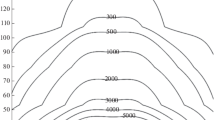Abstract
The efficiency of energetic electron cyclotron acceleration in the Earth’s magnetosphere in different regimes of electron resonant interaction with parallel propagating whistler mode waves of variable frequency, specifically, with chorus ELF-VLF emissions, is considered. The regime of stochastic acceleration, typical of the interaction between particles and noise-like emissions, and particle acceleration in the regime of nonlinear trapping by a quasimonochromatic wave field are discussed. The specific feature of the latter regime consists in its non-diffuse character, i.e., the definite sign of the energy variation depending on the frequency variation in the wave packet. The trapped electron energy becomes higher if frequency increases within an element, which is typical of chorus emissions. For the parameters typical of chorus emissions (the amplitude of a wave magnetic field B ∼ = 102 nT, the initial frequency ω ∼ 0.3ω H , and the frequency variation &Dω ∼ 0.15ω H , where ω H is the electron gyrofrequency), the energy increase during one act of such an interaction at L = 4−5 exceeds the rms variation in the energy of untrapped electron (during stochastic acceleration) by one-two orders of magnitude. The estimates indicate that a considerable fraction (several tens of percent) of the chorus element energy can be absorbed by electrons accelerated in the trapping regime during a single hop.
Similar content being viewed by others
References
A. G. Demekhov and V. Y. Trakhtengerts, “On the Dynamics of the Magnetospheric Cyclotron ELFVLF Maser in the Backward Wave Oscillator Regime. I. Initial Equations and Results in an Approximation of a Homogeneous Magnetic Field,” Izv. Vyssh. Uchebn. Zaved., Radiofiz. 48, 719–729 (2005) [Radiophys. Quantum Electron. 48, 639–649 (2005)].
A. G. Demekhov, V. Y. Trakhtengerts, M. J. Rycroft, and D. Nunn, “Electron Acceleration in the Magnetosphere by Whistler-Mode Waves of Varying Frequency,” Geomagn. Aeron. 46(6), 751–756 (2006) [Geomagn. Aeron. 46, 711–716 (2006)].
R. H. W. Friedel, G. D. Reeves, and T. Obara, “Relativistic Electron Dynamics in the Inner Magnetospherea Review,” J. Atmos. Sol.-Terr. Phys. 64, 265–282 (2002).
S. A. Glauert and R. B. Horne, “Calculation of Pitch Angle and Energy Diffusion Coefficients with the PADIE Code,” J. Geophys. Res. 110, 206 (2005).
V. I. Karpman, Y. N. Istomin, and D. R. Shklyar, “Nonlinear Theory of a Quasimonochromatic Whistler Mode Packet in Inhomogeneous Plasma,” IEEE Trans. Plasma Sci. 16, 685–703 (1974).
N. P. Meredith, M. Cain, R. B. Horne, et al., “Evidence for Chorus Driven Electron Acceleration to Relativistic Energies from a Survey of Geomagnetically Disturbed Periods,” J. Geophys. Res. 108, 1248 (2003).
T. P. O’Brien, K. R. Lorentzen, I. R. Mann, et al., “Energization of Relativistic Electrons in the Presence of ULF Power and MeV Microbursts: Evidence for Dual ULF and VLF Acceleration,” J. Geophys. Res. 108, 1329 (2003).
Y. Omura, N. Furuya, and D. Summers, “Relativistic Turning Acceleration of Resonant Electrons by Coherent Whistler Mode Waves in a Dipole Magnetic Field,” J. Geophys. Res. 112, A06236 (2007).
Y. Y. Shprits and R. M. Thorne, “Time Dependent Radial Diffusion Modeling of Relativistic Electrons with Realistic Loss Rates,” Geophys. Res. Lett. 31, L08.805 (2004).
D. Summers and C. Ma, “A Model for Generating Relativistic Electrons in the Earth’s Inner Magnetosphere Based on Gyroresonant Wave-Particle Interactions,” J. Geophys. Res. 105, 2625–2639 (2000).
D. Summers, C. Ma, and T. Mukai, “Competition between Acceleration and Loss Mechanisms of Relativistic Electrons during Geomagnetic Storms,” J. Geophys. Res. 109, A04221 (2004).
E. V. Suvorov and M. D. Tokman, “To the Theory of Accelerated Electron Generation during Cyclotron Plasma Heating,” Fiz. Plazmy 14, 950–957 (1988).
V. Y. Trakhtengerts, “A Generation Mechanism for Chorus Emission,” Ann. Geophys. 17, 95–100 (1999).
V. Y. Trakhtengerts, “Magnetosphere Cyclotron Maser: Backward Wave Oscillator Generation Regime,” J. Geophys. Res. 100, 17 205–17 210 (1995).
V. Y. Trakhtengerts, A. G. Demekhov, E. E. Titova, et al., “Interpretation of Cluster Data on Chorus Emissions Using the Backward Wave Oscillator Model,” Phys. Plasmas 11, 1345–1351 (2004).
V. Y. Trakhtengerts, M. J. Rycroft, D. Nunn, and A. G. Demekhov, “Cyclotron Acceleration of Radiation Belt Electrons by Whistlers,” J. Geophys. Res. 108, 1138 (2003).
L. V. Tverskaya, N. N. Pavlova, J. B. Blake, et al., “Predicting the L Position of the Storm Injected Relativistic Electron Belt,” Adv. Space Res. 31, 1039–1044 (2003).
Author information
Authors and Affiliations
Corresponding author
Additional information
Original Russian Text © A.G. Demekhov, V.Yu. Trakhtengerts, M. Rycroft, D. Nunn, 2009, published in Geomagnetizm i Aeronomiya, 2009, Vol. 49, No. 1, pp. 28–33.
Rights and permissions
About this article
Cite this article
Demekhov, A.G., Trakhtengerts, V.Y., Rycroft, M. et al. Efficiency of electron acceleration in the Earth’s magnetosphere by whistler mode waves. Geomagn. Aeron. 49, 24–29 (2009). https://doi.org/10.1134/S0016793209010034
Received:
Published:
Issue Date:
DOI: https://doi.org/10.1134/S0016793209010034



